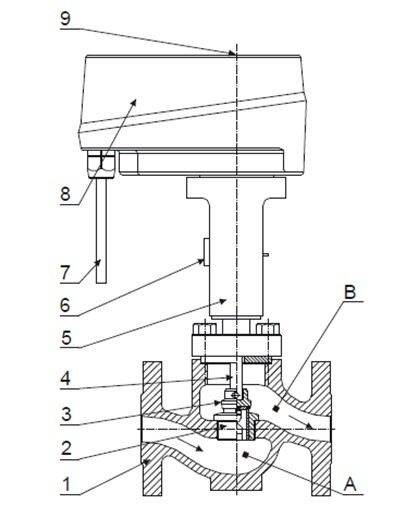Comparing Industrial Valve Drive Systems: Pneumatic, Electric, and Hydraulic
In the rapidly evolving industrial landscape, valves and their drive systems are pivotal in automated control systems. Pneumatic, electric, and hydraulic systems are popular choices among various driving methods. This article offers a detailed comparison of these systems for industrial valves, concluding with recommendations for optimal selection. By assessing factors like structure, pros and cons, and applicability, we aim to guide the adoption of a safer and more efficient drive system in industrial production.
Pneumatic Actuated Valves and Actuators
Pneumatic actuators are devices driven by compressed air and exhibit the following characteristics:

1. Advantages:
2. Disadvantages:
Electric Actuated Valves and Actuators
Electric valves are controlled by electric actuators and exhibit the following characteristics:

1. Advantages:
2. Disadvantages:
Hydraulic Actuated Valves and Actuators
Hydraulic actuators operate through hydraulic pressure to open, close, or regulate valves, and they exhibit the following characteristics:

1. Advantages:
2. Disadvantages:
When selecting pneumatic, electric, or hydraulic drive systems, a comprehensive consideration of specific application scenarios, valve types, work specifications, and locations is essential. Each drive method has its unique advantages and limitations, necessitating a careful balance of various factors according to specific needs. Choosing the most suitable drive system, while ensuring system safety and efficient operation, will bring greater benefits to industrial production.
Pneumatic Actuated Valves and Actuators
Pneumatic actuators are devices driven by compressed air and exhibit the following characteristics:

1. Advantages:
Simple structure: The design of pneumatic actuators is relatively simple, making them widely applicable in various industrial settings.
Easy access to air source: Air is an easily accessible resource, contributing to the widespread applicability of pneumatic actuators in diverse industrial environments.
High switching speed: Pneumatic actuators can respond quickly, achieving high switching speeds.
Flexible speed control: Speed can be flexibly adjusted by installing speed controllers.
Gas cushioning: Possesses elasticity when closing, enhancing system stability.
Easy access to air source: Air is an easily accessible resource, contributing to the widespread applicability of pneumatic actuators in diverse industrial environments.
High switching speed: Pneumatic actuators can respond quickly, achieving high switching speeds.
Flexible speed control: Speed can be flexibly adjusted by installing speed controllers.
Gas cushioning: Possesses elasticity when closing, enhancing system stability.
2. Disadvantages:
Larger structure: In comparison to hydraulic actuators, pneumatic actuators may appear larger in high-pressure valves with large diameters.
Uneven speed: Due to the compressibility of gases, maintaining uniform speed during operation may be challenging.
Uneven speed: Due to the compressibility of gases, maintaining uniform speed during operation may be challenging.
Electric Actuated Valves and Actuators
Electric valves are controlled by electric actuators and exhibit the following characteristics:

1. Advantages:
Wide applicability: Electric actuators have strong adaptability, unaffected by environmental temperatures.
Wide range of output torque: Capable of providing a broad range of output torques suitable for different valve sizes.
Convenient control: Can freely adopt various signals, supporting amplification, memory, logic judgment, and calculation.
Miniaturization: Capable of achieving miniaturization, suitable for limited-space environments.
Mechanical self-locking: Possesses mechanical self-locking, enhancing system safety.
Easy installation and maintenance: Convenient installation, relatively easy maintenance and inspection.
Wide range of output torque: Capable of providing a broad range of output torques suitable for different valve sizes.
Convenient control: Can freely adopt various signals, supporting amplification, memory, logic judgment, and calculation.
Miniaturization: Capable of achieving miniaturization, suitable for limited-space environments.
Mechanical self-locking: Possesses mechanical self-locking, enhancing system safety.
Easy installation and maintenance: Convenient installation, relatively easy maintenance and inspection.
2. Disadvantages:
Complex structure: The structure of electric actuators is relatively complex, potentially increasing maintenance difficulty.
Low mechanical efficiency: Mechanical efficiency generally ranges from 25% to 60%, lower compared to other drive methods.
Output speed limitations: Output speed cannot be too low or too high and needs adjustment based on specific circumstances.
Sensitivity to power fluctuations: Susceptible to changes in power voltage and frequency.
Low mechanical efficiency: Mechanical efficiency generally ranges from 25% to 60%, lower compared to other drive methods.
Output speed limitations: Output speed cannot be too low or too high and needs adjustment based on specific circumstances.
Sensitivity to power fluctuations: Susceptible to changes in power voltage and frequency.
Hydraulic Actuated Valves and Actuators
Hydraulic actuators operate through hydraulic pressure to open, close, or regulate valves, and they exhibit the following characteristics:

1. Advantages:
Simple and compact structure: Relatively simple structure with a small footprint.
High output force: Capable of providing substantial output force.
Infinite variable speed: Easily achieves low or high speeds, enabling infinite variable speed control.
Remote automatic control: Capable of remote automatic control, even fully submerged for underwater control.
High efficiency: Due to the viscosity of hydraulic oil, it operates with high efficiency and provides self-lubrication and rust prevention.
High output force: Capable of providing substantial output force.
Infinite variable speed: Easily achieves low or high speeds, enabling infinite variable speed control.
Remote automatic control: Capable of remote automatic control, even fully submerged for underwater control.
High efficiency: Due to the viscosity of hydraulic oil, it operates with high efficiency and provides self-lubrication and rust prevention.
2. Disadvantages:
Impact of oil temperature changes: Changes in oil temperature may affect oil viscosity, impacting system stability.
Prone to leakage: Hydraulic components and pipelines are prone to leakage, requiring regular maintenance.
Inconvenient piping and maintenance: Piping and maintenance are relatively inconvenient.
Not suitable for signal processing: Not suitable for various signal processing operations.
Prone to leakage: Hydraulic components and pipelines are prone to leakage, requiring regular maintenance.
Inconvenient piping and maintenance: Piping and maintenance are relatively inconvenient.
Not suitable for signal processing: Not suitable for various signal processing operations.
When selecting pneumatic, electric, or hydraulic drive systems, a comprehensive consideration of specific application scenarios, valve types, work specifications, and locations is essential. Each drive method has its unique advantages and limitations, necessitating a careful balance of various factors according to specific needs. Choosing the most suitable drive system, while ensuring system safety and efficient operation, will bring greater benefits to industrial production.

